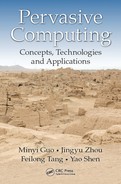Contents
1 Pervasive Computing Concepts
1.1 Perspectives of Pervasive Computing
1.1.1 Technology Trend Overview
1.1.2 Pervasive Computing: Concepts
1.3.4 Human–Computer Interaction
1.3.5 Pervasive Transaction Processing
1.3.6 User Preference and Recommendations
2 The Structure and Elements of Pervasive Computing Systems
2.1 Infrastructure and Devices
2.2 Middleware for Pervasive Computing Systems
2.3 Pervasive Computing Environments
3 Context Collection, User Tracking, and Context Reasoning
3.1 Context Collection and Wireless Sensor Networks
3.1.2 Context Collection Framework
3.2.2 Mobile Robot Position Identification
3.2.3 Intelligent Urban Traffic Management
3.3.3 Propagating Evidence in the Sensors Layer
3.3.4 Propagating Evidence in the Objects Layer
3.3.5 Recognizing User Activity
3.3.6 Evidence Selection Strategy
4 Resource Management in Pervasive Computing
4.1 Efficient Resource Allocation in Pervasive Environments
4.1.1 Introduction to PMP Systems
4.1.2 Pipeline-Based Resource Allocation
4.1.3 Probabilistic Approach-Based Resource Allocation
4.2 Transparent Task Migration
4.2.1 Introduction to Task Migration
4.2.2.2 OZ Source File Reorganization
4.2.2.4 Application State Persistence and Recovery
4.2.3.1 Resource Handle Transformation Schema
4.2.3.2 Resource Transformation Schema
4.2.4 xMozart: A Novel Platform for Intelligent Task Migration
4.2.4.1 Migration Management Modules
4.2.4.3 Multimodal Programming in xMozart
4.2.5 Implementation and Illustrations
4.2.5.1 Prototype for Application Migration
4.2.5.2 Prototype for Multimodalities
5 Human–Computer Interface in Pervasive Environments
5.2 HCI Service and Interaction Migration
5.3 Context-Driven HCI Service Selection
5.3.1 Interaction Service Selection Overview
5.3.2.1 Service-Oriented Middleware Support
5.3.2.2 User History and Preference
5.3.5 Global Combination Selection
5.3.5.3 Service Combination Selection Algorithm
5.4 Scenario Study: Video Calls at a Smart Office
5.4.1.1 The Smart Office Environment
5.5 A Web Service–Based HCI Migration Framework
5.5.1 HCI Migration Support Environment
5.5.2 Interaction Requirements Description
5.5.3 Interaction Devices Manager
5.5.5 Runtime Migration Demonstration
6 Pervasive Mobile Transactions
6.1 Introduction to Pervasive Transactions
6.2 Mobile Transaction Framework
6.2.1 Unavailable Transaction Service
6.2.2 Pervasive Transaction Processing Framework
6.3 Context-Aware Pervasive Transaction Model
6.3.1 Context Model for Pervasive Transaction Processing
6.3.2 Context-Aware Pervasive Transaction Model
6.3.3 A Case of Pervasive Transactions
6.4 Dynamic Transaction Management
6.4.1 Context-Aware Transaction Coordination Mechanism
6.4.2 Coordination Algorithm for Pervasive Transactions
6.5 Formal Transaction Verification
6.5.1 Petri Net with Selective Transition
6.5.2 Petri Net–Based Formal Verification
7 User Preferences and Recommendations
7.1 Content-Based Recommendation in an RSS Reader
7.2 A Collaborative Filtering-Based Recommendation
7.2.1 Background on Collaborative Filtering
7.3 Preference-Based Top-K Recommendation in Social Networks
7.3.2 Computing User Preferences
7.3.3 Greedy Algorithm for Mining Top-K Nodes
7.3.4.2 Algorithms and Metrics
7.3.4.3 Study on Influence Spread
8.1.1 iShadow: Pervasive Computing Environment
8.1.2 Applications in iCampus Prototype
8.2 IPSpace: An IPv6-Enabled Intelligent Space
8.2.1 IPSpace Architecture Overview
